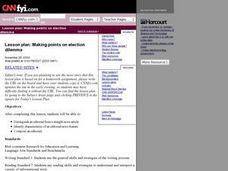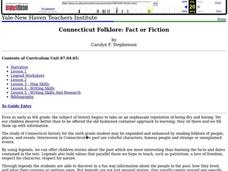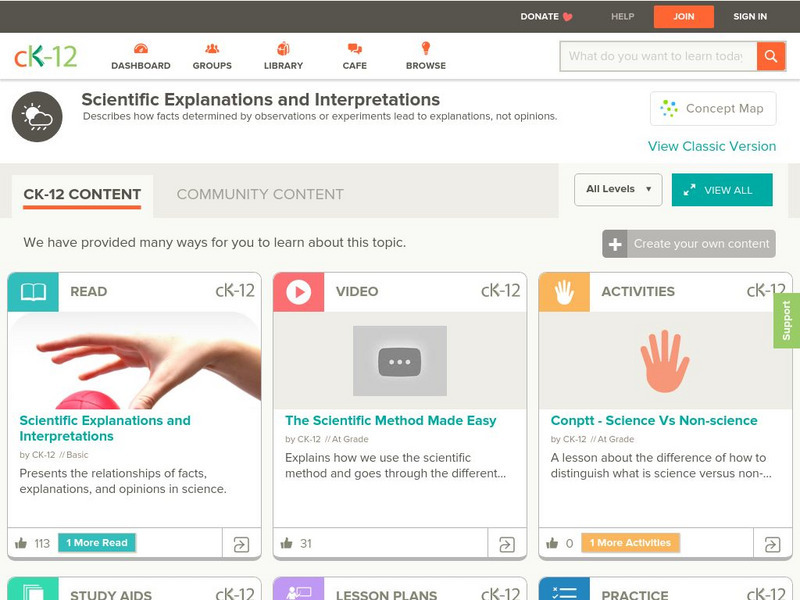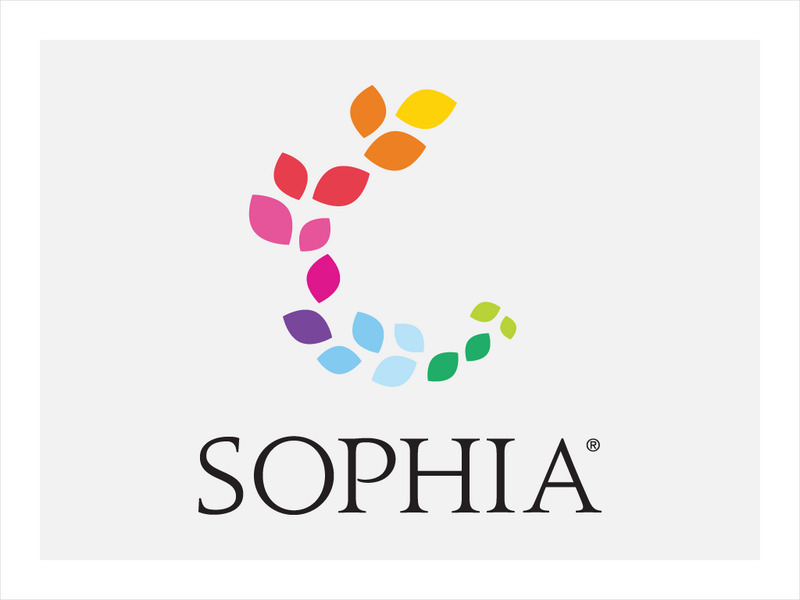Curated OER
Animation
Students explore the field of animation to describe characters and express opinions. They view pictures of cartoon characters, clips of British animation, and read about the making of Valiant. They design their own cartoon character...
Curated OER
Special Delivery-Opinion
Students are introduced to the concept of global climate change. Using data, they determine how much of the world is being affected by the increase in temperatures. They complete a worksheet and consider the evidence giving to them and...
Curated OER
Funny or Not - Your Opinion
Students interpret and judge the meaning of a political cartoon. They dicuss the cartoons in groups and write an evaluative paragraph which they present to the class.
Curated OER
Media Scrapbook
Learners analyze the fundamental issues relating to Canadian parliamentary democracy through the exploration of media and public opinion. A scrapbook is created containing summaries of the work performed.
Curated OER
Is That a Fact, Harry?
Students use excerpts from books to determine whether sentences are fact, fiction, or opinion. They state reasons for their choices.
Curated OER
Uniform Blues
Fourth graders explore what the U.S. Constitution is and why it is important, the purpose of the state constitution, and its relationship to the U.S. Constitution and the similarities and differences among federal, state and local...
Curated OER
Fact versus Opinion
Eleventh graders distinguish between fact and fiction in a one day selection of the Official Proceedings of the Alabama 1901 Constitution
Curated OER
Making Points on Election Dilemma
Young scholars define a straight news article, and identify characteristics of an editorial news feature. They read a CNN article that examines the 2000 presidential election, and determine what is factual and what is opinion.
Curated OER
Students as Historians: Investigating the Gulf War
Sixth graders investigate the Gulf War using primary and secondary sources. Students research using a variety of sources including the internet.
Curated OER
Connecticut Folklore: Fact or Fiction
Sixth graders read legends to learn the history of Connecticut in a fun informative way.
York University
Classics in History of Psychology: Cognitive Consequences of Forced Compliance
This page is a part of the Classics in the History of Psychology site. First published in 1959 this paper looks at what happens to a person's private opinion when he/she is forced to do or say something contrary to that opinion.
Other
Debate Central: Learn About Debating
This web site has debate information on how to debate, how to judge, how to coach, how to be a better speaker and how to research.
CK-12 Foundation
Ck 12: Scientific Explanations and Interpretations
[Free Registration/Login may be required to access all resource tools.] Students learn about scientific explanations and interpretations through instructional videos, grade-level texts, interactive activities, and quick assessments.
Texas Education Agency
Texas Gateway: Differentiate Substantiated and Unsubstantiated Opinions in Text
[Accessible by TX Educators. Free Registration/Login Required] In this lesson, students will learn to differentiate fact from opinion and to decide whether an opinion is substantiated or not.
Texas Education Agency
Texas Gateway: Distinguish Between Summary and Critique (English I Reading)
In this lesson, students will learn how to write an effective summary using reading strategies to help ensure that the summary contains enough information without including unnecessary details or personal opinions. You will also learn...
Texas Education Agency
Texas Gateway: Distinguish Between Summary and Critique (English Ii Reading)
This lesson will focus on summary and critique separately so that you can distinguish between the two. You will learn how to summarize a text and how to distinguish between essential and nonessential information when summarizing. You...
Polk Brothers Foundation Center for Urban Education at DePaul University
De Paul University: Center for Urban Education: I Can Classify Facts and Opinions [Pdf]
A T-Chart is provided for students to use as they classify facts and opinions. Students will explain how to determine facts and opinions after completing the T-Chart.
ReadWriteThink
Read Write Think: Considering a Feminist Perspective
This lesson plan explores issues surrounding understanding perspective and the power of opinion. Included in the lesson plan is an overview, practice, objectives, resources, preparation, and more.
Sophia Learning
Sophia: Supporting Details Explained
This slideshow focuses on supporting details; it discusses their purpose, the audience, and the point to be made. It lists the five most common types of supporting details: facts, statistics, opinions, examples, and personal observations...
SMART Technologies
Smart: Fact vs. Opinion
In this activity provided by SMART, students will learn and practice separating fact from opinion.
Other
Great Thinkers and Visionaries: Books by Albert Einstein
This site has a comprehensive listing of over 50 books written by Einstein. Each has a link to Amazon, listing availability, cost, short synopsis.
Other
Theory Into Practice: Cognitive Dissonance
This site from the Theory Into Practice website provides a simple and straitforward explaination of the Cognitive Dissonance theory. The page gives a good example of the theory in action and references for further information.


















![De Paul University: Center for Urban Education: I Can Classify Facts and Opinions [Pdf] Graphic De Paul University: Center for Urban Education: I Can Classify Facts and Opinions [Pdf] Graphic](https://d15y2dacu3jp90.cloudfront.net/images/attachment_defaults/resource/large/FPO-knovation.png)


